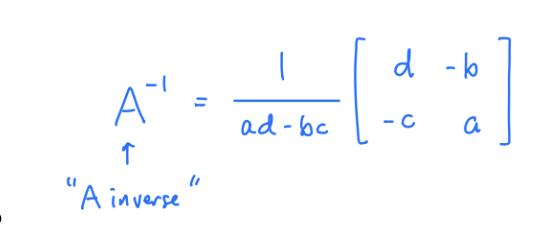linear final
1/33
Earn XP
Name | Mastery | Learn | Test | Matching | Spaced |
|---|
No study sessions yet.
34 Terms
How to tell if a matrix is one-to-one?
It is one to one if it only has trivial solution / columns are linearly independent.
How to tell if a matrix is onto?
If there is a pivot in every row.
If given radians remember:
cos -sin
sin cos
If given T(es) = (points)
then it is columns.
If given T(es) = (equations)
then those are rows.
If a matrix is a rectangle
then it is linearly dependent.
If a matrix has a zero vector
then linearly dependent
If a matrix has a column that is a multiple of another
then linearly dependent
How to find the inverse of a 2x2 matrix?

How to solve a linear system using an inverse?
Take inverse and multiply it with b. Ax = b -> A-1b = x
What happens if a triangle of zeroes below a diagonal?
The product of the diagonal is the determinant
Can also reduce to form the zero triangle to get the determinant
Cramer’s Rule
Find determinant
Replace the x,y,z columns with the RHS.
Find dx/d, dy/d, dz/d
Find determinants of matrices (up to 4 × 4) (3.1 and 3.2)
Show that a set of vectors is a basis for a vector space (4.3)
An indexed set of vectors B in V is a basis for H if
B is linearly independent (check)
H spans B (find if it is invertible. If det 0, then it is invertible)
To find basis for Nul A (Kernel)
Solve Ax = 0
Write solution in parametric vector form
The vectors are are the solution
Find a basis for Col A
Reduce to echelon form
Identify pivots
The corresponding column in A itself form the basis
To find a basis for Row A
Reduce to echelon form
The nonzero rows will be the basis.
What is rank and nullity?
Rank = Number of vectors for basis of Col A
Nullity = Number of vectors for basis of Nul A
Rank Nullity Theorem = Rank + Nullity = # of columns in original A
Find the coordinates of a given vector v (in terms of a basis B) and its corresponding coordinate vector [v]B (4.4)
Given coordinate vector and basis:
take the coordinate vector, and distribute it to the basis
Find the coordinates of a given vector v (in terms of a basis B) and its corresponding coordinate vector [v]B (4.4)
Given coordinate vector and basis:
take the coordinate vector, and distribute it to the basis
Find the coordinates of a given vector v (in terms of a basis B) and its corresponding coordinate vector [v]B (4.4)
Given basis and x
: Augment basis with x.
Find the coordinates of a given vector v (in terms of a basis B) and its corresponding coordinate vector [v]B (4.4)
Use coordinates to check that polynomials are linearly dependent
Turn the polynomials into columns
Augment with zero.
Determine if a given vector is an eigenvector of a given matrix (5.1)
If given vectors, multiply matrix with eigenvector
If the answer is a multiple of the vector, then it is an evector.
What happens if zero is along diagonal as an eigenvalue?
Matrix is not invertible
Determine if a given number λ is an eigenvalue of a given matrix A (by analyzing A − λI) (5.1)
Subtract matrix from the eigenvalue
Augment with zero, and see if it is linearly independent.
If dependent, then it is an eigenvalue
If asked for the corresponding eigenvectors
Find the weird form. That is the vector
Find the eigenvalues of a matrix (5.2).
Subtract lambda from the matrix
Find determinant and set equal to zero
Factor to get eigenvalues.
Determine whether a given matrix is invertible based on its eigenvalues (5.2)
A matrix A is invertible if and only if all of its eigenvalues are non-zero.
Diagonalize a matrix (up to 3 × 3) by finding a diagonal matrix D and a matrix P such that A = PDP^−1 (5.3).
To diagonalize a given matrix
Subtract diagonal by eigenvalues.
Find determinant
Factor determinant, those are your eigenvalues
D = eigenvalues in diagonal
P = Find 3 linearly independent eigenvectors
Subtract matrix from eigenvalues, augment with zero.
Find weird form, that is the P.
Find the length of a vector (6.1).
Find norm, sqrt(u^2 + v^2)
Normalize a vector:
Find unit vector
Determine if two vectors are orthogonal
Dot product, if zero, then orthogonal
Show that a given set of vectors is an orthogonal basis for a subspace of R^n (6.2)
Find if all are orthogonal, then check determinant and LI
Find the projection of a vector onto a subspace (6.3).

Find the distance between a vector and a subspace (6.3).
